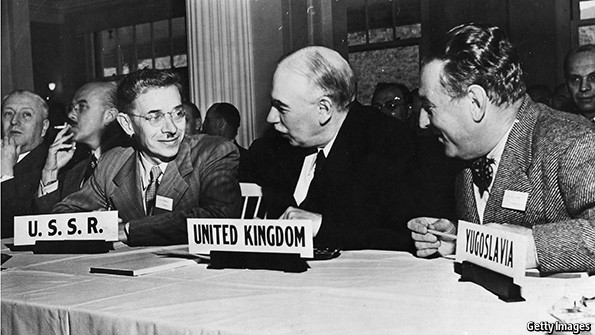
ON JULY 1ST 1944 the rich world’s finance experts convened in a hotel in the New Hampshire mountains to discuss the post-war monetary system. The Bretton Woods system that emerged from the conference saw the creation of two global institutions that still play important roles today, the International Monetary Fund (IMF) and the World Bank. It also instituted a fixed exchange-rate system that lasted until the early 1970s.
A key motivation for participants at the conference was a sense that the inter-war financial system had been chaotic, seeing the collapse of the gold standard, the Great Depression and the rise of protectionism. Henry Morgenthau, America’s Treasury secretary, declared that the conference should “do away with the economic evils—the competitive devaluation and destructive impediments to trade—which preceded the present war.” But the conference had to bridge a tricky transatlantic divide. Its intellectual leader was John Maynard Keynes, the British economist, but the financial power belonged to Harry Dexter White, acting as American President Roosevelt’s representative.
The strain of maintaining fixed exchange rates had proved too much for countries in the past, especially when their trade accounts fell into deficit. The role of the IMF was designed to deal with this problem, by acting as an international lender of last resort. But while White, as the representative of a creditor nation (and one with a trade surplus), wanted all the burden of adjustment to fall on the debtors, Keynes wanted constraints on the creditors as well. He wanted an international balance-of-payments clearing mechanism based, not on the dollar, but a new currency called bancor. White worried that America would end up being paid for its exports in “funny money”; Keynes lost the argument. Ironically enough, now that America is a net debtor, White’s administrative successors have called for creditors to bear part of the adjustment when trade balances get out of line.
The Bretton Woods exchange-rate system saw all currencies linked to the dollar, and the dollar linked to gold. To prevent speculation against currency pegs, capital flows were severely restricted. This system was accompanied by more than two decades of rapid economic growth, and a relative paucity of financial crises. But in the end it proved too inflexible to deal with the rising economic power of Germany and Japan, and America’s reluctance to adjust its domestic economic policy to maintain the gold peg. President Nixon abandoned the link to gold in 1971 and the fixed exchange-rate system disintegrated.
Both the IMF and World Bank survived. But each has fierce critics, not least for their perceived domination by the rich world. The IMF has been criticised for the conditions it attaches to loans, which have been seen as too focused on austerity and the rights of creditors and too little concerned with the welfare of the poor. The World Bank, which has mainly focused on loans to developing countries, has been criticised for failing to pay sufficient attention to the social and environmental consequences of the projects it funds. It is hard to believe that either institution will be around in another 70 years’ time unless they change to reflect the growing power of emerging markets, particularly China.
